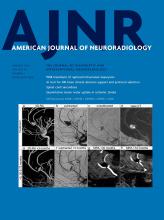We thank Dr Wang1 for the interest and careful review of our article “Emergency Department Visits for Chronic Subdural Hematomas within 30 Days after Surgical Evacuation with and without Middle Meningeal Artery Embolization.”2 Middle meningeal artery (MMA) embolization is a promising treatment technique for chronic subdural hematomas (cSDHs) that is efficacious and safe.3⇓⇓-6 The goal of the aforementioned study was to evaluate the treatment efficacy of MMA embolization using standardized outcome measures as determined by emergency department visits and re-admissions within 30 days. Using a retrospective study design, we demonstrated that surgical evacuation combined with MMA embolization in patients with cSDH is associated with reduced 30-day emergency department use compared with surgical evacuation alone.
First, Dr Wang noted the potential impact on cSDH resolution and recurrence of postoperative medical management, including anticoagulation, antiplatelet, and statin therapy. Although we did not collect data on medical therapy, we provided data on comorbidities, including hypertension, diabetes, coronary artery disease, cerebrovascular events, and coagulopathy, among others, and we found no significant differences between the 2 treatment groups. While we agree that postoperative medical management may be implicated in the treatment outcome of cSDH, the potential influence of these drugs remains a subject of debate. For instance, Chang et al7 reported that antiplatelet therapy adversely affected hematoma resolution at 6 months—a finding that became nonsignificant on multivariate analysis. Other studies reporting similar findings have also expressed concern for an increased risk of thromboembolic events that must be weighed against the contentious risk of hematoma recurrence.8⇓-10
Likewise, there is controversary in the literature about whether statins are predictors of cSDH recurrence. In an institutional study, Housley et al11 reported no differences in complete resolution and recurrence among patients with perioperative statin therapy versus those without statin therapy. In consideration of the ambiguity of postoperative medical management after cSDH treatment, we conclude that randomized controlled studies are needed to decipher the role of postoperative medical therapeutics as independent predictors of treatment outcome and disease recurrence.
Second, Dr Wang raised concern that readmissions unrelated to the index procedure may be a potential source of bias. As stated in the results, the readmission rate was largely higher among patients with an operation alone compared with combined therapy, and of those, most patients were re-admitted due to recurrence or a residual of cSDH. This finding stands in contrast to only 1 patient who was re-admitted for hematoma recurrence after adjuvant MMA embolization. Although we could not statistically compare these groups because of their small sample size, it is unlikely that miscellaneous reasons for re-admission introduced bias of any kind. We agree that longer follow-up of the groups would be of interest and merits future analysis.
Last, we agree with Dr Wang’s concluding remark that large-scale, prospective randomized controlled studies with predetermined outcome measures are required to validate the efficacy of MMA embolization as frontline-versus-adjuvant therapy for the treatment of cSDH.
Footnotes
Disclosures: Dr Ducruet is a consultant for Medtronic, PLC (Dublin, Ireland), Penumbra (Alameda, California), Stryker (Kalamazoo, Michigan), CERENOVUS (Johnson & Johnson Medical Devices Companies, Irvine, California), and Koswire (Flowery Branch, Georgia).
References
- © 2023 by American Journal of Neuroradiology












